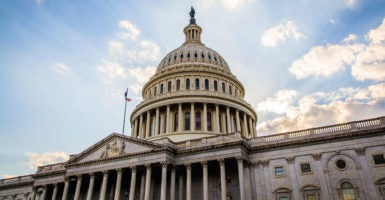Two major issues will dominate the congressional budget debate over the coming months—the debt limit and the future of the Budget Control Act discretionary spending caps.
If past is prologue, Congress may be tempted to deal with the two issues simultaneously as part of one broader debt and spending agreement.
That strategy makes it easier for lawmakers to pass on an unpopular fiscal deadline like the debt limit if paired with massive spending increases to sweeten the deal.
However, to combine the debt limit increase with a spending deal, without first adopting serious fiscal restraint, would undermine the seriousness of the nation’s ever-worsening debt crisis and be a major error.
Congress should debate each issue thoroughly—and separately. Importantly, lawmakers must not make the fiscal situation any worse.
The Bipartisan Budget Act of 2018, signed into law last February, suspended the debt limit through March 1, 2019. This was the fifth suspension of the limit since 2013 and the second time a suspension was included as part of a budget cap deal.
As of Monday, the debt subject to the limit exceeded $22 trillion. On Saturday, a similar total will become the statutory debt limit. The new debt limit will be more than $1.5 trillion higher than in December 2017, the last time a numerical debt limit was in place.
This Saturday, the country will reach the debt limit again. But what does that really mean?
It doesn’t mean that the government will be forced to immediately stop making payments, stop providing services, or the like. The Treasury is permitted to take “extraordinary measures” to continue meeting existing federal obligations so long as no new debt is issued.
However, extraordinary measures will last only so long. April tax receipts will help stem the tide, but the Congressional Budget Office estimates that by fall the federal government will no longer be able to cover its obligations.
As often happens with Congress’ dysfunctional budget process, fiscal year 2020 appropriations and the status of the Budget Control Act spending caps could also come to a head at the same time.
The Budget Control Act established discretionary spending caps from 2012 to 2021. The act has been amended three times to increase spending in two-year increments.
The most recent deal increased spending by $296 billion—without any offsetting spending reductions. All of this increase was piled onto the already ballooning national debt.
The issue at hand with the Budget Control Act is that in the last mega-deal, Congress deliberately created a cliff heading into 2020. Under current law, for spending to remain at the inflated levels would mean a $125 billion increase over what the Budget Control Act provides next year.
Without changes to the law, national defense spending would absorb 57 percent of the cut. By Oct. 1, lawmakers will either have to have fiscal year 2020 appropriations in place or pursue a temporary funding bill to avoid a government shutdown.
While there are numerous options to generate enough discretionary savings to not only properly fund national defense, but also stay within the current law caps, some members of Congress will push for another budget-busting caps deal.
The debt limit and status of the Budget Control Act are two critical issues that will have a sweeping impact on the economy.
The last budget deal was estimated to increase the debt by as much as $2.1 trillion over 10 years.
High levels of debt create a drag on the economy, hurting job creators and the average worker alike.
The debt limit serves as a critical policy tool. Reaching the limit forces Congress and the president to confront the impact of unsustainable spending. It should be a wake-up call for lawmakers and a chance to change course before the situation gets worse.
Combining raising the debt limit with the Budget Control Act debate neglects the seriousness of both issues.
Instead of confronting the debt limit and Budget Control Act caps simultaneously, Congress should separate the two and look for long-term solutions to the spending-driven debt crisis.
The first step should be to stop suspending the debt limit. Instead, lawmakers should set a numerical limit and only increase that limit if it is accompanied by reconciliation legislation that reduces spending by more than the debt limit increase to help curb the tide of red ink in the future.
What’s really needed are new fiscal restraints that address the core drivers of federal spending by imposing spending limits over the entire federal budget—all non-interest outlays—that pave the way to budget balance.
The Budget Control Act caps should also be dealt with separately.
The best solution to the looming funding cliff is for Congress to get serious about prioritizing money based on constitutional needs and live within the aggregate fiscal 2020 budget cap.
Families are forced to prioritize their spending based on actual needs every day. The federal government shouldn’t be held to a lower standard.
If a budget deal becomes inevitable, it must include mandatory spending cuts of at least an equal amount that take effect immediately. If cuts are delayed, Congress should make provisions also to cover the additional cost of interest.
Budgeting is about making trade-offs, and spending decisions have consequences. What happens with the debt limit and Budget Control Act caps will affect all Americans. Each is far too important to be decided in haste or as part of a catch-all budget deal.




























